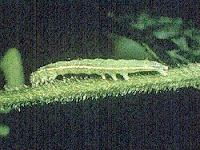Doug
Johnson, Extension Entomologist
After a drop last week to 487 moths/trap-week
from the peak capture of 675 moths/trap-week, capture of fall armyworm (FAW)
moths in the UK-IPM pheromone baited trap has increased to 605 moths/trap-week (See Figure 2.). This
indicates a continued and elevated risk of infestation by this pest for the
next several weeks. This up-tick in moths captured does not indicate another
generation. It is more likely that the cool weather in the previous week
reduced the number of moths flying and the warm up has done just the opposite.
If this is the case, then last week’s moth capture should have been a bit
larger and this week’s a bit lower, making the curve appear a bit more normal.
 |
| Figure 2. 2012 FAW Capture. |
This spiky appearance
to the graph is just due to a small number of data points and a wide span of
time (a week) between data points. What is most important is the fact that
there are still a great many moths flying and females will still be laying eggs
for several more weeks unless there is a drastic change in temperatures. Caterpillars
resulting from the egg lay of the current moth flight have already begun to
appear. I expect that egg lay resulting
from the moths represented by this week’s data point will continue into the
first week of October. Caterpillars resulting from the current egg lay could be
active through the entire month of October. This is, of course, completely
dependent upon temperature.
We would normally expect for the threat from FAW to end on
or about the first killing frost. Certainly we have eggs and caterpillars, in
various stages of growth, currently in the environment that can last past the
average first killing frost date. This does not even account for the moths that
are currently flying, mating and laying eggs.
Thus, small grass crops will remain at risk to infestation
by FAW until the weather changes enough to stop the cycle. This usually occurs with a “killing” frost. Looking at Mr. Tom Priddy’s short-term
forecast, this should be about the normal Oct. 22 date.
FAW is a tropical
insect and cold weather will solve the problem. Nevertheless, experience has
shown me that light frost will not do the trick, even with air temps near or at
freezing. It’s because at the soil / air
level, especially in no-till fields, temperatures may remain above freezing.
This is certainly true for clear sunny days, when the soil litter can obtain
heat from sunlight.
Our current change in weather to rainy cool temperatures
will slow this insect down. In addition these conditions will select in favor
of the cool season grass that have recently been planted. You will need to
continue scouting of these new stands, but weather is looking more favorable.
At risk crops remain the same, with the possible exception
of soybeans. Most of these should be beyond the stage that leaf damage will be
important. Sowing or renovating pastures, waterways, and cover crops with any
small grass needs to be scouted for FAW. Sowing wheat earlier than the Hessian Fly free
date will increase the risk of FAW problems. Even sowing on or after the
Hessian Fly free day may not provide control if the normal killing frost is
late.
Having talked to many producers, consultants, and farm
service personnel, it is apparent that the problem remains in detecting the
infestation. Control, once the infestation has been spotted, does not seem to
be a problem.
Several common questions continue to come up:
Q. If I spray for the
FAW now, will that prevent a future infestation?
A. No. You will probably get some residual
activity from your insecticide, but if the weather stays warm, the insect’s
life cycle will outlast the residual. As the weather grows cold, the
application will be unneeded.
Q. If I treat my wheat seed
with an insecticide, will that control FAW?
A. No, the rates we use on
wheat in KY are meant to control very small sucking insects like aphids and
Hessian flies. Think how much more massive a FAW caterpillar is than an aphid.
This is a rate problem, not whether or not the insecticide would kill FAW.
Q. My pasture is mowed off.
Has FAW killed my pasture?
A. No, it is very unlikely
that FAW will kill an established stand. You will lose your yield, e.g., hay,
stockpile grazing, etc. There is little
difference in FAW and cattle feeding; FAW just have smaller feet!
Q. FAW has eaten up my newly
sown pasture / waterway / wheat; has it killed my seedlings?
A. This
is impossible to answer without waiting & watching for re-growth. FAW does
not usually kill established grasses. However, if the root system is not well
established, some seedlings may die. My
experience with wheat tells me you should be careful about reseeding. I have seen FAW graze off a field, making it
look dead, then the producer reseeding as soon as possible and ending up with a
“double seeding”. This results in many
problems in the spring.


















